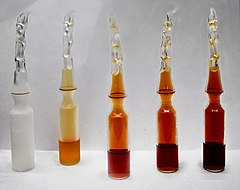Nitrogen dioxide
|
|
|||
 Nitrogen dioxide at −196 °C, 0 °C, 23 °C, 35 °C, and 50 °C. (NO
2) converts to the colorless dinitrogen tetroxide (N 2O 4) at low temperatures, and reverts to NO 2 at higher temperatures. |
|||
| Names | |||
|---|---|---|---|
|
IUPAC name
Nitrogen dioxide
|
|||
| Other names
Nitrogen(IV) oxide, Deutoxide of nitrogen
|
|||
| Identifiers | |||
|
10102-44-0 |
|||
| 3D model (Jmol) |
Interactive image Interactive image |
||
| ChEBI |
CHEBI:33101 |
||
| ChemSpider |
2297499 |
||
| ECHA InfoCard | 100.030.234 | ||
| EC Number | 233-272-6 | ||
| 976 | |||
| PubChem | 3032552 | ||
| RTECS number | QW9800000 | ||
| UNII |
S7G510RUBH |
||
| UN number | 1067 | ||
|
|||
|
|||
| Properties | |||
| NO• 2 |
|||
| Molar mass | 46.0055 g mol−1 | ||
| Appearance | Vivid orange gas | ||
| Odor | Chlorine like | ||
| Density | 1.88 g dm−3 | ||
| Melting point | −11.2 °C (11.8 °F; 261.9 K) | ||
| Boiling point | 21.2 °C (70.2 °F; 294.3 K) | ||
| Hydrolyses | |||
| Solubility | soluble in CCl 4, nitric acid,chloroform |
||
| Vapor pressure | 98.80 kPa (at 20 °C) | ||
| +150.0·10−6 cm3/mol | |||
|
Refractive index (nD)
|
1.449 (at 20 °C) | ||
| Structure | |||
| C2v | |||
| Bent | |||
| Thermochemistry | |||
| 37.5 J/mol K | |||
|
Std molar
entropy (S |
240 J mol−1 K−1 | ||
|
Std enthalpy of
formation (ΔfH |
+34 kJ mol−1 | ||
| Hazards | |||
| Main hazards | Poison, oxidizer | ||
| Safety data sheet | ICSC 0930 | ||
| GHS pictograms |
    
|
||
| GHS signal word | Danger | ||
| H270, H314, H330 | |||
| P220, P260, P280, P284, P305+351+338, P310 | |||
|
EU classification (DSD)
|
|
||
| R-phrases | R26, R34, R8 | ||
| S-phrases | (S1/2), S9, S26, S28, S36/37/39, S45 | ||
| NFPA 704 | |||
| Lethal dose or concentration (LD, LC): | |||
|
LC50 (median concentration)
|
30 ppm (guinea pig, 1 hr) 315 ppm (rabbit, 15 min) 68 ppm (rat, 4 hr) 138 ppm (rat, 30 min) 1000 ppm (mouse, 10 min) |
||
|
LCLo (lowest published)
|
64 ppm (dog, 8 hr) 64 ppm (monkey, 8 hr) |
||
| US health exposure limits (NIOSH): | |||
|
PEL (Permissible)
|
C 5 ppm (9 mg/m3) | ||
|
REL (Recommended)
|
ST 1 ppm (1.8 mg/m3) | ||
|
IDLH (Immediate danger)
|
20 ppm | ||
| Related compounds | |||
|
Related Nitrogen oxides
|
Dinitrogen pentoxide Dinitrogen tetroxide |
||
|
Except where otherwise noted, data are given for materials in their standard state (at 25 °C [77 °F], 100 kPa).
|
|||
|
|
|||
| Infobox references | |||
Dinitrogen tetroxide
Dinitrogen trioxide
Nitric oxide
Nitrous oxide
Nitrogen dioxide is the chemical compound with the formula NO
2. It is one of several nitrogen oxides. NO
2 is an intermediate in the industrial synthesis of nitric acid, millions of tons of which are produced each year. At higher temperatures it is a reddish-brown gas that has a characteristic sharp, biting odor and is a prominent air pollutant. Nitrogen dioxide is a paramagnetic, bent molecule with C2vpoint group symmetry.
Nitrogen dioxide is a reddish-brown gas above 70 °F (21 °C; 294 K) with a pungent, acrid odor, becomes a yellowish-brown liquid below 70 °F (21 °C; 294 K), and converts to the colorless dinitrogen tetroxide (N
2O
4) below 15 °F (−9 °C; 264 K).
The bond length between the nitrogen atom and the oxygen atom is 119.7 pm. This bond length is consistent with a bond order between one and two.
Unlike ozone, O3, the ground electronic state of nitrogen dioxide is a doublet state, since nitrogen has one unpaired electron, which decreases the alpha effect compared with nitrite and creates a weak bonding interaction with the oxygen lone pairs. The lone electron in NO
2 also means that this compound is a free radical, so the formula for nitrogen dioxide is often written as •NO
2.
...
Wikipedia



